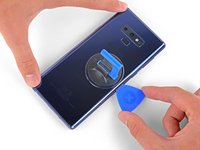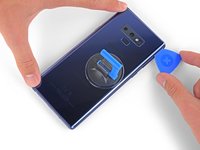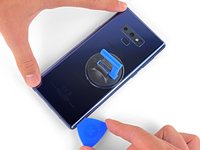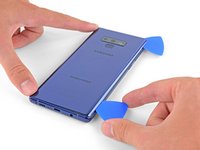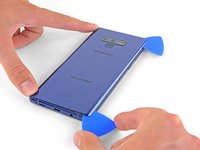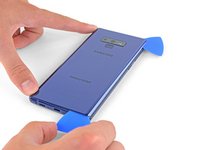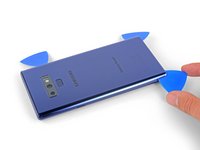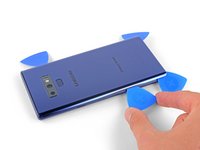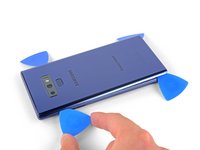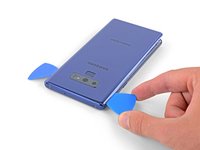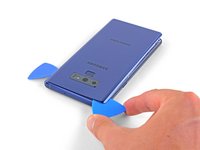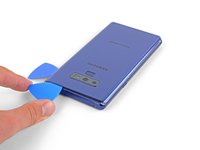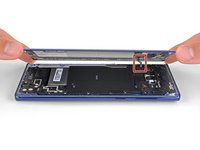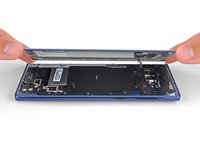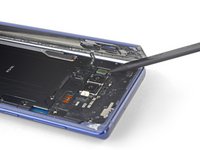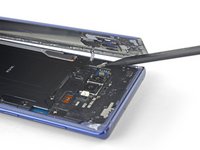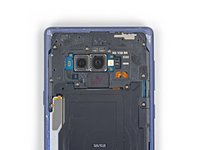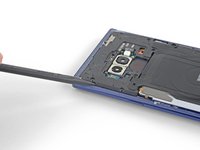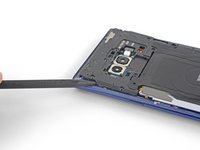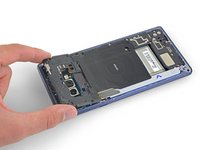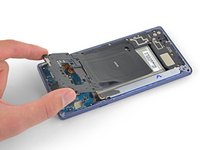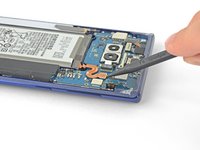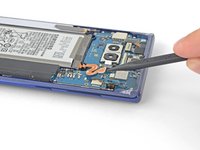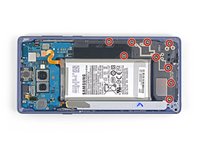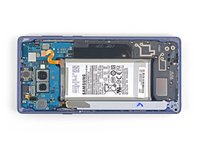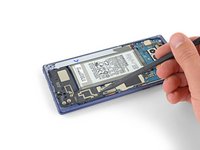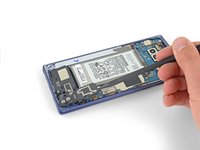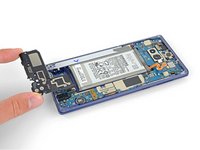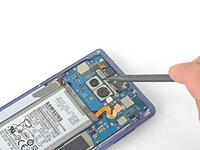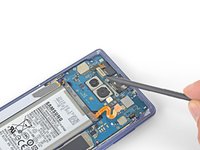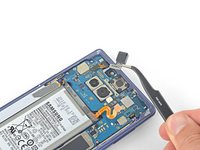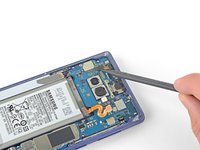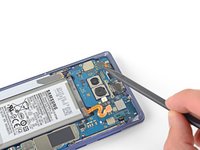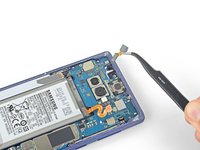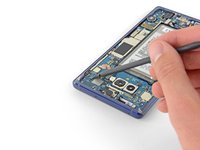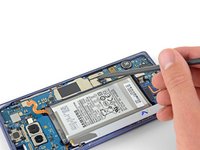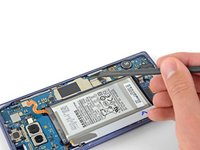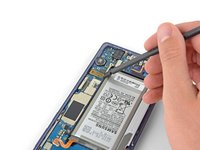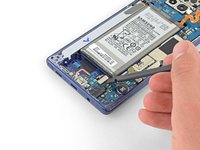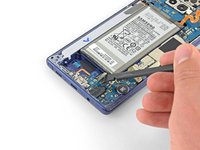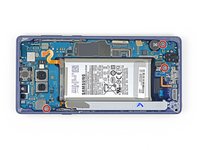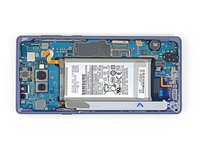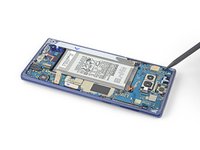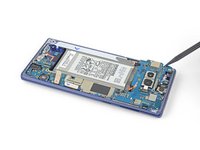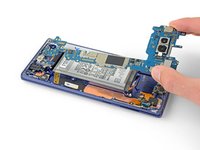Deze vertaling geeft mogelijk niet de meest recente updates van de bronhandleiding weer. Help ons met het updaten van de vertaling of bekijk de bronhandleiding.
Inleiding
Een beschadigd moederbord kan ervoor zorgen dat omliggende onderdelen niet goed functioneren en kan voorkomen dat je telefoon niet meer aangaat. Als je denkt dat je moederbord deze of andere problemen veroorzaakt, kun je deze handleiding gebruiken om het moederbord van je Samsung Galaxy Note9 te vervangen.
Wat je nodig hebt
-
-
Steek een uitwerptool in de kleine opening in de SIM-kaarthouder.
-
Druk op de tool om de SIM-kaarthouder uit te werpen.
-
-
-
Schakel je telefoon uit voordat je begint met het demonteren.
-
Gebruik een föhn, warmtepistool of prepareer een iOpener en leg deze direct op de rechterzijde van de achterkant van de telefoon gedurende een minuut. Hierdoor wordt de lijm eronder verzacht.
If using an iOpener it will need to be fully heated and set on for at least 5 minutes. You’ll know the phone is hot enough when its almost too hot to touch.
Just came here to say exactly that. The instructions should be amended to state that: "Get it fully hot and leave it there for at least three minutes solid."
-
-
-
Druk een zuignap op de achterste behuizing.
-
Til de zuignap op om zo een opening te creëren tussen de achterste behuizing en het frame van de telefoon.
-
Steek een openingsplectrum in de opening.
It takes so much heat that it is concerning that damage might be caused to the internal parts. It is difficult to heat the glue, pull the case apart and insert the pick at same time. May need some more pointers to handle these situations first, to prevent possible damage. Also what about the glue that is heated and then cooled before opening? Does it run inside and cause greater adhesion after it cools? Another thing, the handling may cause the phone to turn back on while working to separate. Don't know that that is of concern.
-
-
-
Let erop dat er zich meer lijm aan de bovenkant van de telefoon en rondom de camerarand bevindt dan in de rest van de telefoon.
-
Wees bij het doorsnijden van de lijm aan de linkerkant van de telefoon extra voorzichtig en zorg dat je de lintkabel van de vingerafdruksensor niet beschadigt.
It's extremely easy to crack the back glass when nearing and rounding the corners. It's probably a good idea to soften the adhesive with heat as you go.
Step 5 is NOT "cut through the adhesive", that's steps 5-10. Step 5 is "Begin the careful process of cutting through the adhesive, starting at the right side where you already softened it. Proceed carefully, slowly, and warmly through the following steps."
These comments are spot-on. I never break a phone, and I cracked the back glass following the instructions without seeing these comments first. Heat the back much more than you think you need and go super, super slow.
The bottom inner adhesive layer reaches higher than what you see in the diagram above, so you will have to insert the pick deeper at the bottom and the sides along the bottom to separate the inner adhesive area. Just don't force the corners of the covers upward too much to keep from cracking the glass.
-
-
-
Snijd de lijm door door je openingsplectrum, beginnend in het midden, aan de rechterkant van de telefoon naar boven en naar beneden te schuiven.
-
-
-
Laat een plectrum in de rechter bovenhoek zitten.
-
Gebruik een andere openingsplectrum om de lijm rondom de rechter onderhoek door te snijden.
-
Laat ook deze plectrum zitten.
There seems to be a lot of glue at the bottom, I broke the glass as I was cutting past the charging port - not sure if it was already fractured or just not enough heat (I used Sellotape so it didn't break up into pieces!)
I think LOTS of heat & patience is the key!
Be very careful around the corners and bottom (probably top too, but I didn't have a problem there). Make sure you've cut in far enough down the side first (go in about 1cm) but less round the corners and work in slowly.
-
-
-
Gebruik een föhn of een warmtepistool of leg een verwarmde iOpener aan de linkerkant van de achterste behuizing gedurende een minuut om de lijm eronder te verzachten.
If using an iOpener it will need to be fully heated and set on for at least 5 minutes. You’ll know the phone is hot enough when its almost too hot to touch.
-
-
-
Steek een openingsplectrum in de linker onderhoek van het achterste paneel.
-
Snijd de lijm langs de linkerzijde van het achterste paneel door met een andere plectrum.
Aside from the left edge where the fingerprint sensor cable is, you may have to insert the pick up to 2cm on the sides and top, and a little further along the bottom, and swipe sideways to separate the inner adhesive areas. If one side doesn't separate fully, just apply heat, insert the pick deeper into the phone, and swipe sideways until the back cover detaches. There isn't a need to apply much vertical force, especially on the corners, since the cover will just pop up once all the adhesive has been sliced by the pick.
-
-
-
Snijd de lijm langs de linker bovenhoek van het achterste paneel door met behulp van een openingsplectrum.
-
Snijd tot slot de laatste stukjes lijm langs de bovenkant van de telefoon ook door.
Be VERY patient as you slide the opening picks around the periphery of the glass, and use heat very liberally. Make sure the smooth, clear aspect of the iOpener is against the glass, not the rough black portion.
-
-
-
-
Haal de rechterzijde van de achterste behuizing als eerste los.
-
Kantel de behuizing vanaf de rechterzijde omhoog (en gebruik de linkerzijde als scharnier) om de lintkabel van de vingerafdruksensor bloot te leggen.
Thought I'd done something wrong here as there wasn't a cable attached to the back - the fingerprint reader hadn't come away with the back, but had stayed with the phone.
Exactly the same experience. Made life a little easier.
Happened to me as well.
-
-
-
Gebruik de punt van een spudger om de lintkabel van de vingerafdruksensor omhoog en uit het contact te duwen.
-
-
-
Verwijder de achterste behuizing.
-
Gebruik je een pincet om alle lijmresten uit het chassis van de telefoon te halen. Vervolgens maak je deze gebieden schoon met hooggeconcentreerde isopropyl alcohol (minimaal 90%) en een stuk stofvrij doek om het oppervlakte klaar te maken voor nieuwe lijm.
-
Breng de nieuwe lijm voorzichtig in de achterste behuizing aan. Breng vervolgens een kant van het glas langs de zijkant van het chassis van de telefoon aan en druk het glas stevig in de telefoon.
I am installing a new backplate (this is my first repair; I was CERTAIN that I would crack the back glass, and I was NOT wrong) but I’m not sure how tweezers are meant to remove gooey adhesive! I simply used the blue plastic pry tool as a scraper and gently rolled up the goo. Maybe the glue is different because I have a refurbished phone? That may also explain why I had so much trouble with Step 1. Hope that this helps!
Use tweezers remove any inner adhesive strips that may have started peeling off when the back cover is removed, or adhesive clumps. If an adhesive starts to peel off, use tweezers to pull the strip off completely, and then replace only that removed adhesive strip. Actually, the iFixIt inner adhesive strips don't seem to have the white non-stick areas that are on the original adhesive strips. Thus, it seems ok to keep the original inner adhesive strips if still attached to the phone.
The outer adhesive border is like a good, not a strip, and should be replaced. Using isopropyl alcohol to rub off only the edge adhesive on the phone and back cover works well.
After adding a new outer adhesive and reattaching the back cover, you have one try to align and replace the cover. The cover might not attach flush onto the phone with no side gaps, due to the outer adhesive strip placement. It is probably sufficient if the outer adhesive seals all the way around the back cover border.
While testing the phone after battery replacement, but before reattaching the back cover, if a thermal warning (triangular thermometer icon) appears during charging that prevents charging over 50%, remove the charging cable and use a lightly warmed iOpener or heat gun on the battery to warm it slightly. Once the battery is warmed up a little, reattach the charging cable, and the error should go away. Battery charging can be resumed. This assumes no hardware was damaged during battery replacement.
-
-
Stap 14 Verwijder het bovenste midframe
Voorzichtig: stappen 14-17 komen van een handleiding die in bewerking is.
-
Gebruik een Phillips-schroevendraaier om de negen 4 mm lange schroeven, die het bovenste midframe bevestigen, te verwijderen.
There are two more screws on the bottom right corner of the little side frame that the Qi plate is glued to. I took those out as it put less stress on it.
It helps to hold the fine tweezers with your non-dominant hand to support the screw heads and ensure they come straight out; you can also gently lift as you unscrew.
-
-
-
Trek de draadloze oplaadspoel van de batterij, beginnend aan de linkerkant.
-
-
-
Gebruik de punt van een spudger om de oranje lintkabel, die de batterij aan het moederbord verbindt, los te koppelen.
-
-
-
Verwijder de negen 4 mm lange Phillips-schroeven die de plastic cover naast de batterij bevestigen.
-
-
-
Gebruik de punt van een spudger om de voorste camera-aansluiting in een rechte beweging uit het contact omhoog te duwen.
-
Gebruik een pincet om de voorste camera te verwijderen.
-
-
-
Gebruik de punt van een spudger om de iris-scanner van het moederbord los te koppelen.
-
Gebruik een pincet om de iris-scanner te verwijderen.
-
-
-
Gebruik het platte einde van een spudger om de voorste sensoraansluiting uit het contact omhoog te duwen.
-
-
-
Gebruik het platte einde van een spudger om de schermkabel van het moederbord los te koppelen.
-
-
-
Gebruik het platte einde van een spudger om de oplaadmodule van het moederbord los te koppelen.
These screws are supposed to be 3.2 mm because when I took out these screws, they were shorter than the ones you take out first
-
Om je toestel weer in elkaar te zetten, volg je deze instructies in omgekeerde volgorde.
Breng je e-afval naar een door R2 of e-Stewards gecertificeerde recycler.
Ging je reparatie niet zoals gepland? Check dan ons Antwoordenforum voor hulp bij het oplossen van je probleem.
Vergelijk je vervangende onderdeel met het originele onderdeel — het kan zijn dat je meerdere onderdelen mee over moet zetten of beschermlagen voor de lijm moet verwijderen voordat je het nieuwe onderdeel kunt installeren.
Om je toestel weer in elkaar te zetten, volg je deze instructies in omgekeerde volgorde.
Breng je e-afval naar een door R2 of e-Stewards gecertificeerde recycler.
Ging je reparatie niet zoals gepland? Check dan ons Antwoordenforum voor hulp bij het oplossen van je probleem.
Vergelijk je vervangende onderdeel met het originele onderdeel — het kan zijn dat je meerdere onderdelen mee over moet zetten of beschermlagen voor de lijm moet verwijderen voordat je het nieuwe onderdeel kunt installeren.
Annuleren: ik heb deze handleiding niet afgemaakt.
9 andere personen hebben deze handleiding voltooid.
Met dank aan deze vertalers:
95%
Thomas Keulemans helpt ons de wereld te herstellen! Wil je bijdragen?
Begin met vertalen ›
6Gids Commentaar
Thats a really great instruction. I also have a question. Can I replace the internal memory in a new Note 9 phone from an old Note 9 Phone? If yes, will it work and does it have to be same storage size?
Thank you
Thank you! Unfortunately this is not possible because the memory is soldered to the motherboard. What you can do is swap the entire motherboard from an old phone into the new one but I haven’t tested this myself so I can’t guarantee that everything will work properly. I expect it to work though—including for larger storage sizes—because I do not know of any parts that are paired to the motherboard on those phones.
Hi, can i replace a dual sim Note 9 with a single sim Motherboard?
I can't use the wifi
The phone turn off after i activate it
Do you have any idea to fix the problem?
















